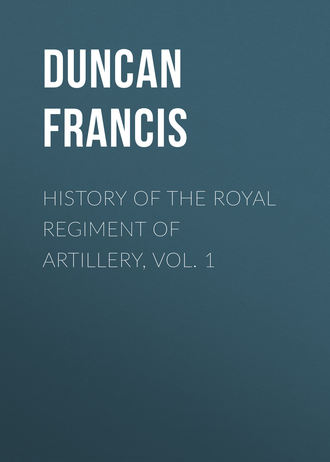 полная версия
полная версияHistory of the Royal Regiment of Artillery, Vol. 1
Already the motto – not to be given until 1832 – had been earned; already Ubique represented the services of the corps; already Quo fas et gloria ducunt represented the aspirations of its members.
Much jealousy had been displayed by the other arms of the service; but it merely served to consolidate the scattered Regiment, and to awaken as decided a Regimental esprit, as existed in smaller and less distributed corps. The decisions on points of difference had almost invariably been in favour of the Royal Artillery: in 1756 the Artillery were directed to take the right of other troops on parade; and every argument as to the status of the officers was answered in their favour up to 1751, when all doubt on the subject was removed, and all discussion ceased, by the King instead of the Master-General signing their commissions.
On every occasion when the services of the corps were required, the zeal and ability of officers and men were readily acknowledged; and their conscientiousness in duty was as conspicuous as their knowledge of their profession. And with this sense of duty and professional skill, came that loveable feeling so well described in the words quoted in the introductory chapter of this volume. "It has ever been our pride, as a corps, to be regarded as one family; and if one member of it, in any remote part of the world, in any way distinguished himself, it was felt universally that he had reflected credit and honour on the whole corps." In this gathering among the woods on Shooter's Hill, on that November night, this Regimental feeling found expression.49
Many of the readers of this volume are doubtless familiar with the beautiful interior of the new Garrison Church at Woolwich, the Walhalla of the Royal Artillery. Over the communion table, memorial windows have been placed by the officers of the Regiment, "To the glory of God, and in commemoration of the services of their Corps during the great wars with France and Russia." As autumn deepens into winter, and the twilight comes down during the evening service, many must have noticed how with the dying light all the figures in the painted windows sink away in shadow and darkness, with the exception of the centre figure, whose pale form – ghastly pale as Rubens' Dead Christ in Antwerp Cathedral – seems to start out from the darkness, and become more distinct as the others fade away.
Is the simile far-fetched – it certainly is not irreverent – to say that, as out of the gathering chancel-gloom He, the great emblem of affection and duty, seems to come and linger among his worshippers, so out of the twilight of the receding years there seems to stand amid all the dimness and uncertainty of details – the confusion of figures – the forgetfulness of even great facts, a grand eloquent figure of Duty, learnt in stern warfare, impressed in no idle peace, and loved in exact proportion as the heart became inspired by increasing esprit, and enlarged by unselfish pride?
Duty needs not love, nor encouragement, to make it noble; but a warm blush comes into the marble cheek, and a quickened pulse to the strong heart, when affection and duty go hand in hand, and the two great lessons of the God-man – love and obedience – blend unconsciously into one.
During the sixty-seven years of the Regiment's existence, at the date when this chapter concludes, this blending had gradually and surely been effected; the fierce and selfish spirit of the pre-regimental trains had disappeared, and an unselfish ambition had taken its place.
Who shall say that in the sympathy of numbers there is not a power incalculable? And who can say that in its highest sense this sympathy can be attained without either a common object, a common charge, or a common danger? If the Regimental system failed in all else in military life, it succeeds in answering these three requisites. A common object – the attainment of a glory which can be common and yet personal; a common charge – the great legacy of former glory, which a man would be a craven if he let the breath of scorn approach; and a common danger, which on service shall knit every man to his neighbour, and in after times shall bind them together again by sympathies and memory.
At times, indeed, the gloom may be great; the twilight may deepen with unnatural and unexpected rapidity; but even among beaten, and dying, and darkening figures, one must ever stand out in a Corps which has learnt true discipline – a figure which twilight cannot shroud, and which even disaster itself at times may illumine, which not even monotonous routine, nor seemingly valueless tasks can dim – the eternal and divine figure of Duty.
CHAPTER XXX.
History, Succession of Captains, and Present Designationof the Troops and Companies belonging to the RoyalHorse Artillery, the Fifth, Sixth, and Seventh Battalions
Although the Royal Horse Artillery, and the Fifth, Sixth, and Seventh Battalions were formed subsequently to the Peace of 1783, it has been considered desirable to insert a summary of the services of the troops and companies in this volume, without prejudice to a more detailed statement which will be given in the succeeding volume, when their formation will be notified in due chronological order. The Seventh Battalion brings the reader to the commencement of the present century, later than which time it has not been deemed necessary, in this volume, to go.
Commencing with the Royal Horse Artillery, it may be mentioned, shortly, that it was formed on the 1st January, 1793, and at first consisted of two Troops, A and B. On the 1st November in the same year C and D Troops were added, followed, on the 1st November, 1794, by E and F Troops. In September 1801, G Troop was formed, in Ireland, out of some detachments serving in that country; and in June, 1804, H Troop was raised at Woolwich. On 1st February, 1805, I Troop was formed at Colchester, and K Troop at Ballinasloe; L Troop at Woolwich in July of the same year, and M Troop also in 1805, although there is a little uncertainty as to the month. There were also two Rocket Troops, but there is considerable difficulty in tracing their exact history. According to the records of the Royal Horse Artillery, the Second Rocket Troop was formed before the First; but in this particular, as in another presently to be mentioned, these records are inaccurate. The following would appear to be the true statement of the case. In June 1813, some Rocket detachments, under Captain R. Bogue, were ordered to Germany, and were present at the Battle of Leipsic. In 1814 a Rocket Troop was formed at Woolwich, under the command of Captain W. G. Elliot; and on the same day Captain E. C. Whinyates was appointed to the command of the Second Rocket Troop vice Bogue, killed at Leipsic. Now, the Battle of Leipsic was fought in October – 1813, and Captain Whinyates' appointment was dated the 2nd March 1814. It would appear, therefore, that the two Rocket Troops were formed together, out of existing detachments, and that the one formed at Woolwich was named the First, while that formed out of the detachments on the Continent was called the Second. Although the detachments present at Leipsic became the Second Rocket Troop, they were present at that battle not as a troop, but as detachments; and as the troop was reduced on 31st July 1816, their Leipsic services, by some mistake, were afterwards credited to the First Rocket Troop, which would actually appear to have received permission to wear "Leipsic" on its appointments in commemoration of the services, not of itself, but of the defunct troop.
In 1847 rocket carriages were given to all the troops, and the remaining Rocket Troop became I Troop of the Royal Horse Artillery.
In addition to the Second Rocket Troop, D Troop also was reduced in 1816; and, in spite of strong remonstrances, – among others, from the late Sir Robert Gardiner, then Captain of E Troop, – the titles of all the troops below D were changed, E, F, G, H, and I becoming respectively D, E, F, G, and H. The injury and inconvenience caused by this alteration of nomenclature have proved very great. K, L and M Troops were reduced at the same time, but being the juniors, their reduction did not affect the lettering of the others.
In January, 1819, B and G Troops were reduced; but on this occasion no alteration was made in the designations of the other troops. B Troop was reformed on the 1st 1855, as a reserve half-troop, under a Second Captain, and was augmented to a full troop in the following year. G Troop was reformed at Woolwich on the 1st December, 1857, and also K Troop on the same day.
On the 1st July, 1859, with the introduction of the Brigade System, came an alteration in the titles of the troops, which were now designated as Batteries of the Horse Brigade. In 1862, on account of the amalgamation with the East India Company's Artillery, the old Royal Horse Artillery became the First Horse Brigade of the Royal Artillery; and in 1864, to enable the Indian reliefs to be carried on without sending the whole of the old Horse Artillery abroad at one time, the First Horse Brigade was divided into A and B Brigades of the Royal Horse Artillery.
At the date of this work (1872) the following list shows the present designations of the old troops, as they stood in 1859: —

The military operations in which these batteries have been severally engaged, and their succession of Captains, will now be given. The more detailed history given of A Troop – "The Chestnut Troop" – is attributable to the labour taken by its Captain, the late Sir Hew Ross, who completed the records of its active service with his own hand.
A TROOP, R.H.A.,
Now "A" BATTERY, A BRIGADE.
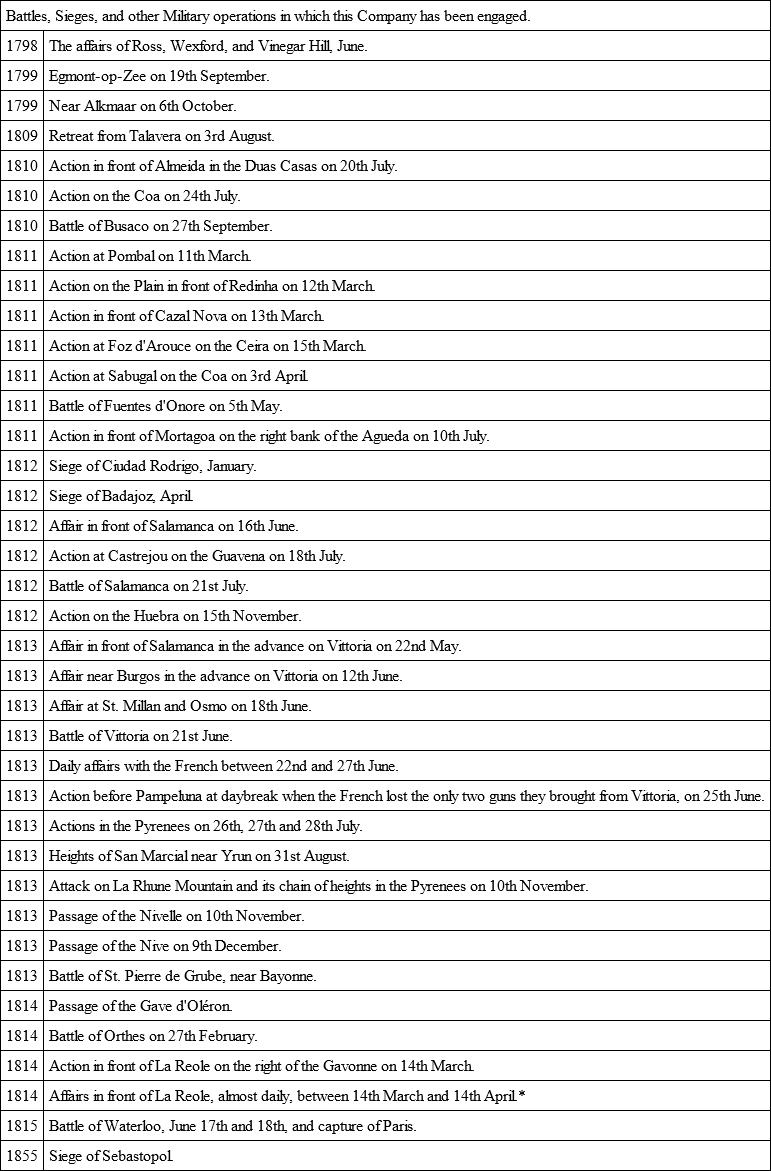
* The Peninsular operations in which this Troop was engaged are copied from Sir Hew Ross's MSS.
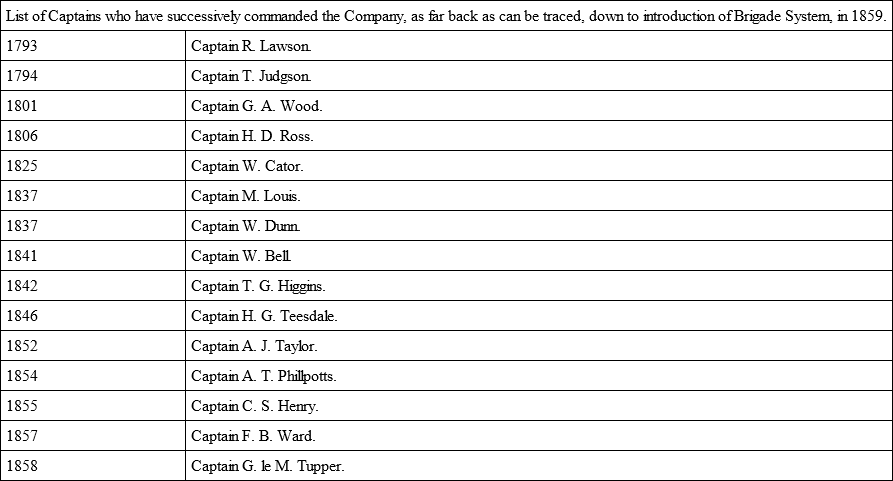
B TROOP, R.H.A.,
Now "B" BATTERY, A BRIGADE.
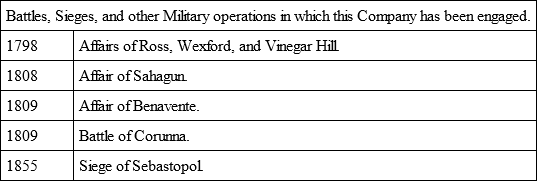
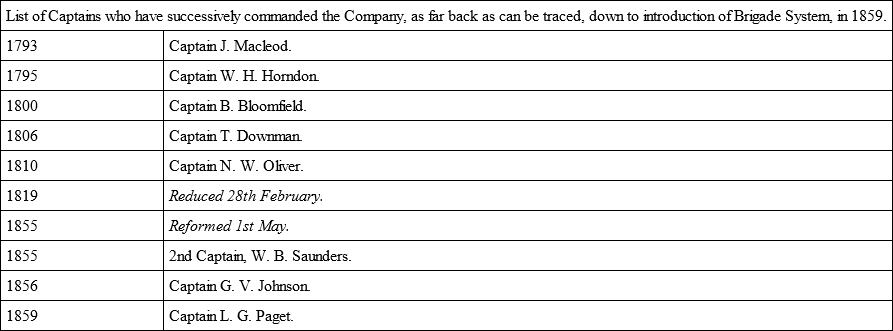
C TROOP, R.H.A.,
Now "C" BATTERY, A BRIGADE.
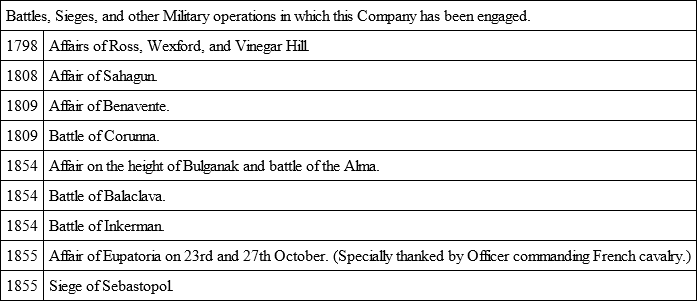
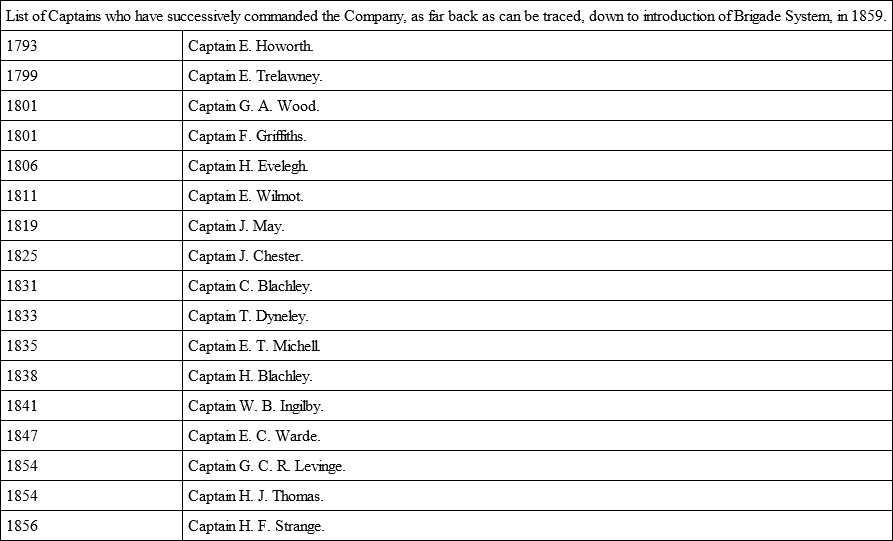
D TROOP, R.H.A.,
Reduced 31st July, 1816.
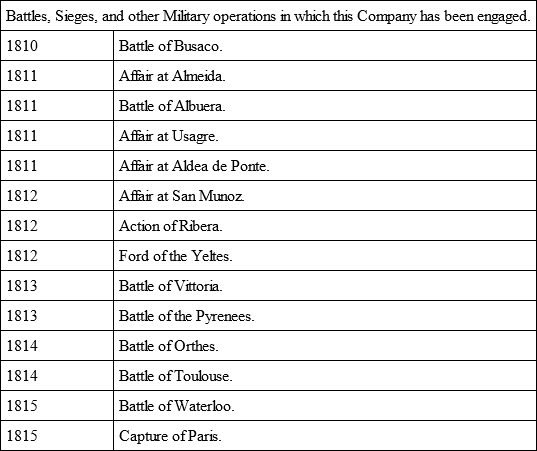

E TROOP, R.H.A.,
Became D on that Troop being reduced in 1816,
Now "A" BATTERY, B BRIGADE.
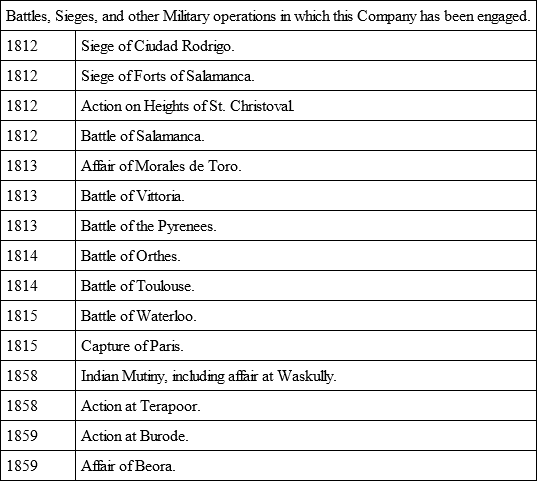
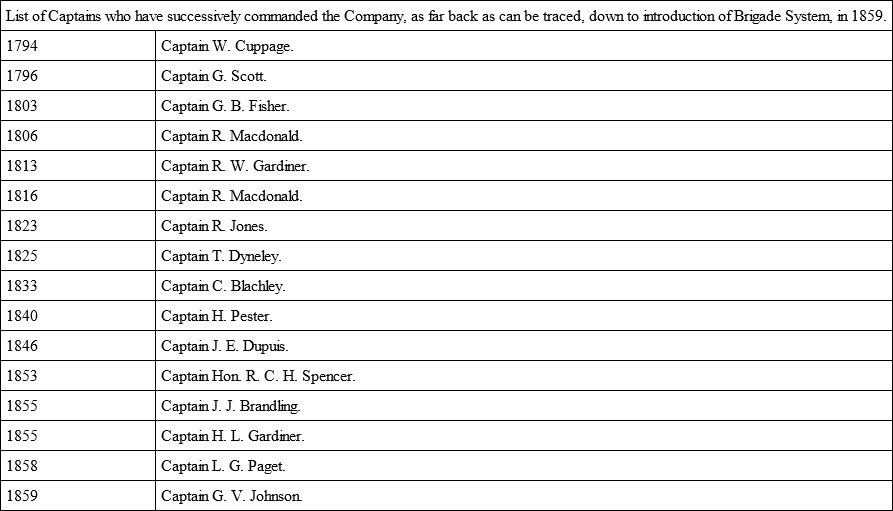
F TROOP, R.H.A. (afterwards E),
Now "B" BATTERY, B BRIGADE.
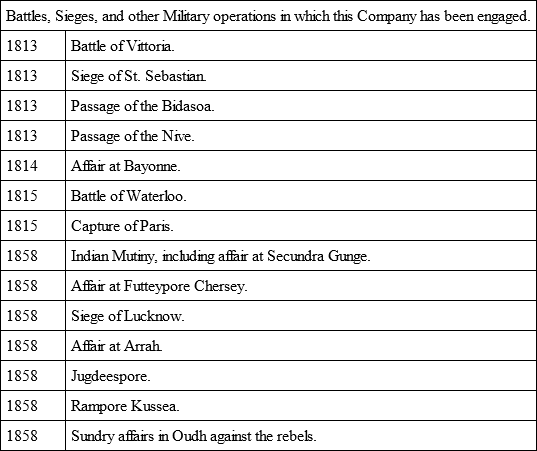
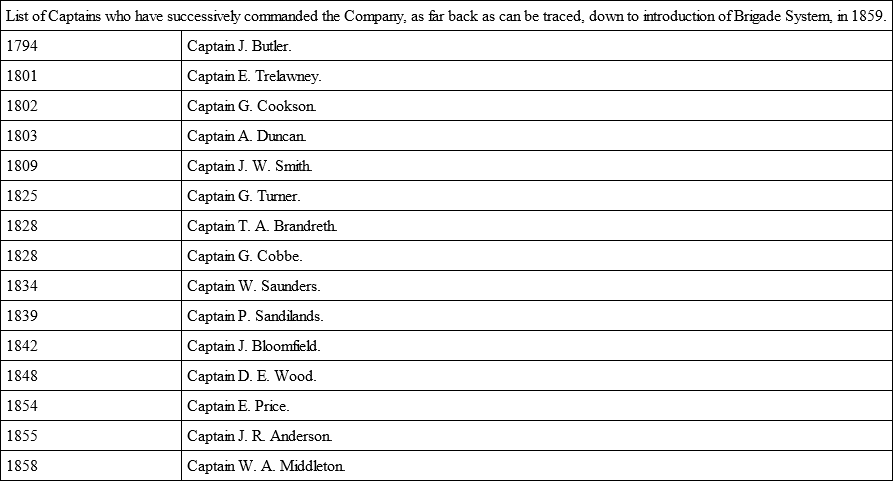
G TROOP, R.H.A. (became F in 1816),
Now "C" BATTERY, B BRIGADE.
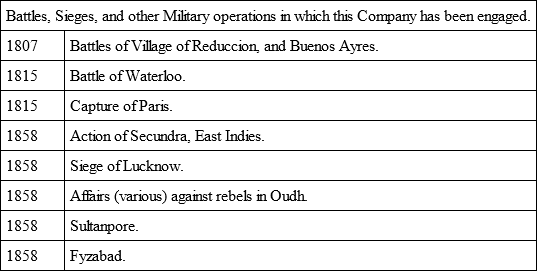
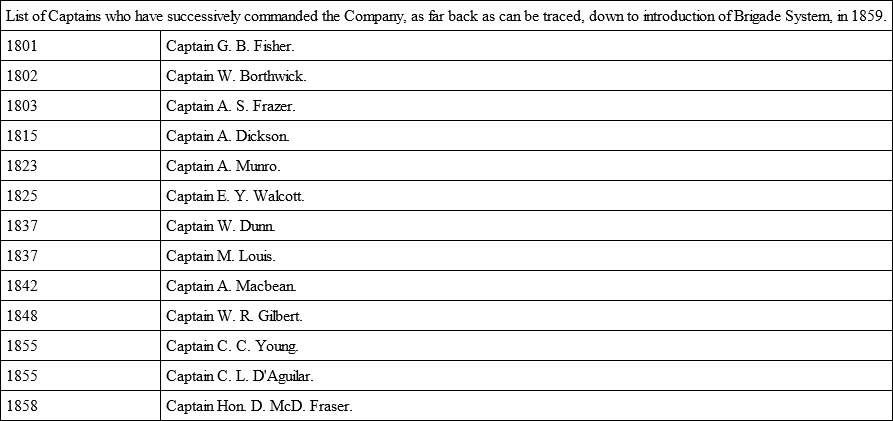
H TROOP, R.H.A. (became G),
Now "D" BATTERY, A BRIGADE.


I TROOP, R.H.A. (became H in 1816),
Now "D" BATTERY, B BRIGADE.
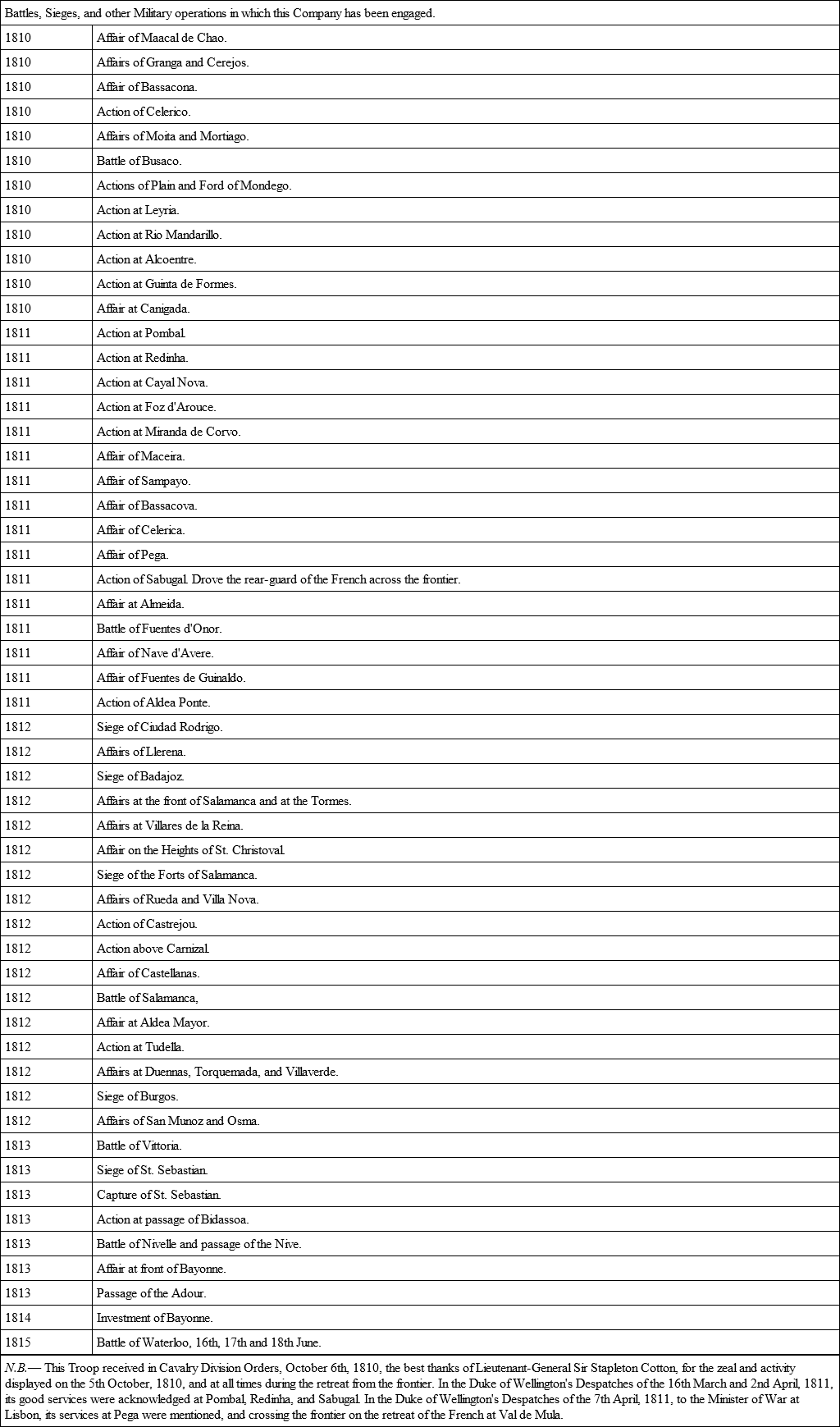

K TROOP, R.H.A.,
Now "E" BATTERY, A BRIGADE.

L TROOP, R.H.A.,
Reduced 31st July, 1816.

* This officer was transferred to D Troop on the reduction of L Troop.
M TROOP, R.H.A.,
Reduced in 1816.

1st ROCKET TROOP (afterwards I TROOP),
Now "E" BATTERY, B BRIGADE.
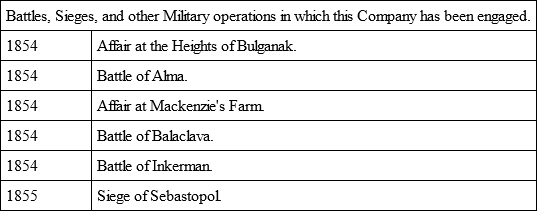

2nd ROCKET TROOP,
Reduced 31st July, 1816.

* Lieutenant T. F. Strangways commanded at this action.

* This officer commanded when it consisted merely of Rocket detachments, and was not yet organized into a Troop. He was killed at Leipsic.
FIFTH BATTALION
On the 14th August, 1794, an augmentation of five companies to the Royal Artillery was sanctioned, to be called, after organization, the Fifth Battalion. The companies were formed, – two at Plymouth and three at Woolwich, – by transfers from other battalions. Major-General Duncan Drummond was appointed Colonel en seconde; the first Lieutenant-Colonel was Edward Williams; and the Major, Robert Douglas. Captains Rogers and Miller commanded the companies formed at Plymouth, and Captains Hutton, Harding, and Sproule, those at Woolwich. The following was the strength of the five companies: —
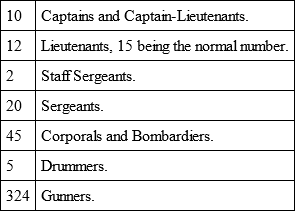
On the 6th March, 1795, five additional companies were added to the battalion; and the total number of companies remained ten until the year 1819, when Nos. 7 and 8 were reduced; Nos. 9 and 10 becoming respectively Nos. 7 and 8.
No very great augmentation to the strength of the battalion took place during the earlier years of its existence, except in the year 1804, when a second Colonel was added, and also twenty men per company. The services of the companies were very varied and distinguished, including the Campaigns in Egypt, Cape of Good Hope, South America, Spain, and Holland.
Annexed is the history of each Company's active service, and the succession of Captains up to the introduction of the Brigade System: —
No. 1 COMPANY, 5th BATTALION,
Now "F" BATTERY, 1st BRIGADE.

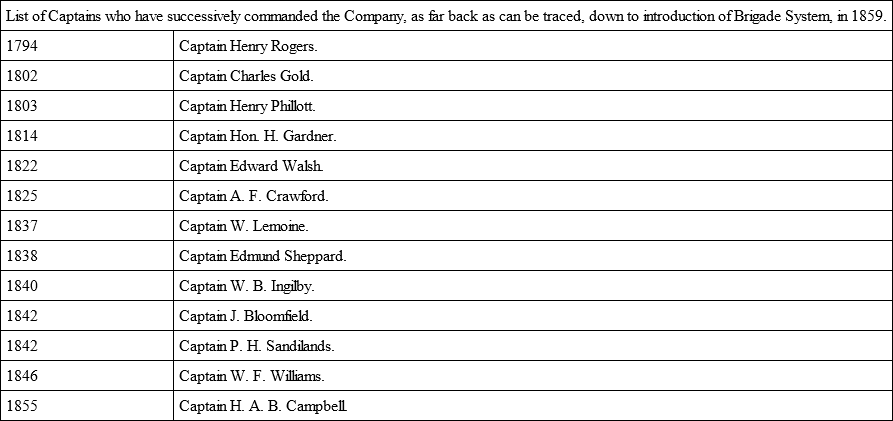
No. 2 COMPANY, 5th BATTALION,
Now "D" BATTERY, 8th BRIGADE.


No. 3 COMPANY, 5th BATTALION
Now "2" BATTERY, 2nd BRIGADE.


No. 4 COMPANY, 5th BATTALION,
Now "3" BATTERY, 2nd BRIGADE.
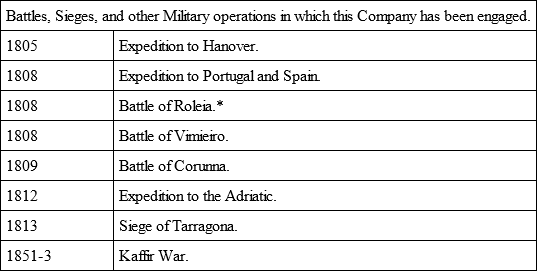
* Captain Geary was killed in command of the Company at Roleia.
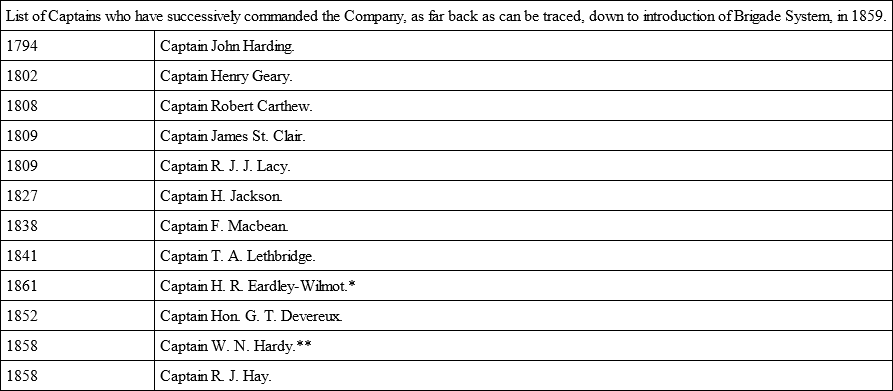
* Killed in action during Kaffir War.
** Captain Hardy was killed at the relief of Lucknow.
No. 5 COMPANY, 5th BATTALION,
Now "1" BATTERY, 5th BRIGADE,
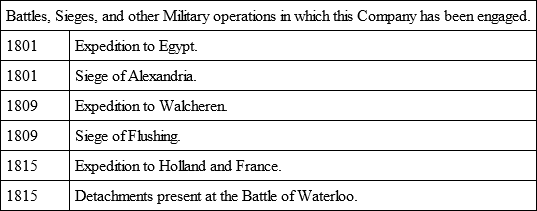
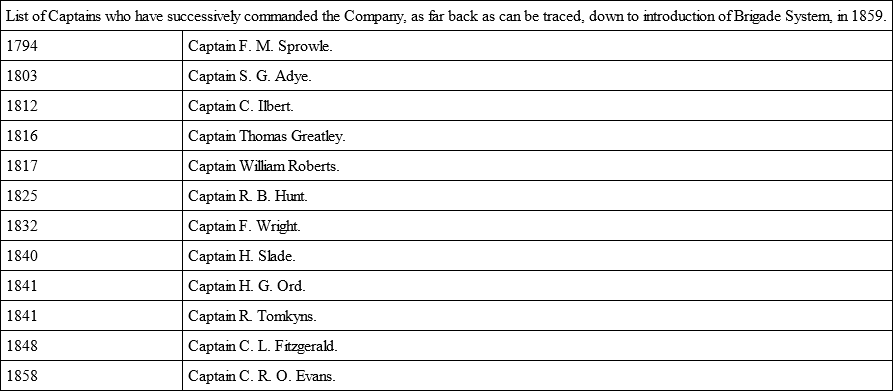
No. 6 COMPANY, 5th BATTALION,
Now "3" BATTERY, 3rd BRIGADE.
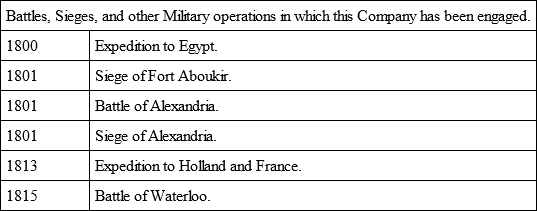
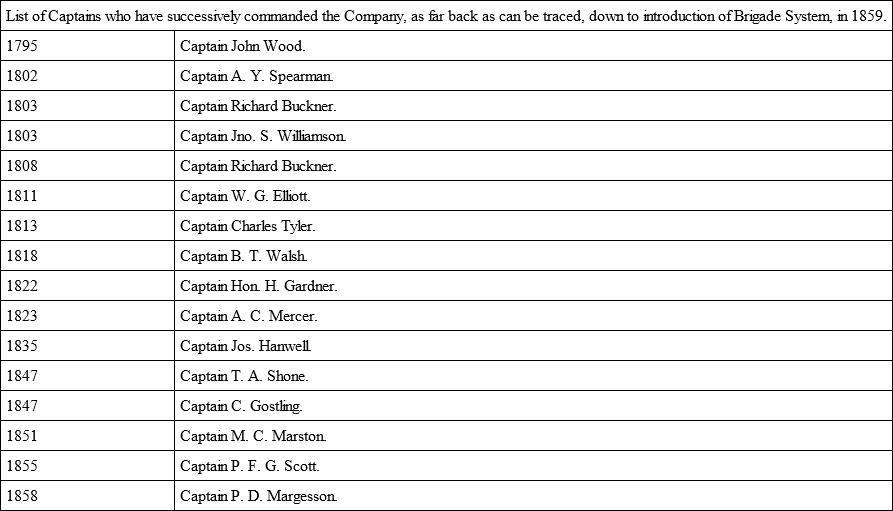
No. 7 COMPANY, 5th BATTALION,
Reduced in 1819.

* Detachments of the Company had been previously employed in the several captures of the enemy's possessions in that quarter since the recommencement of hostilities in 1803.

No. 8 COMPANY, 5th BATTALION,
Reduced in 1819.
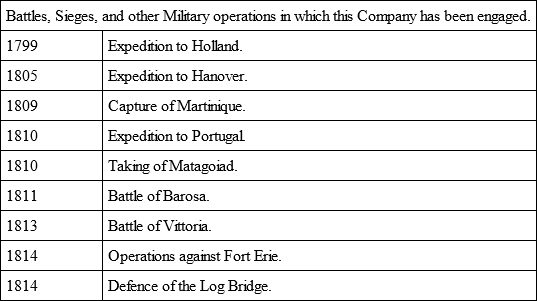

No. 9 COMPANY, 5th BATTALION
(Became No. 7 in 1819),| Now "A" BATTERY, 9th BRIGADE.
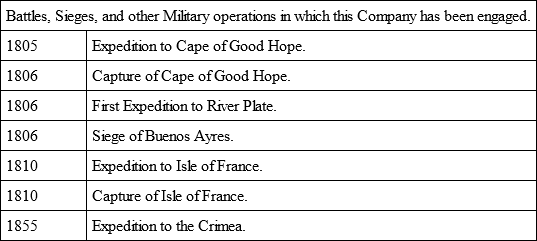
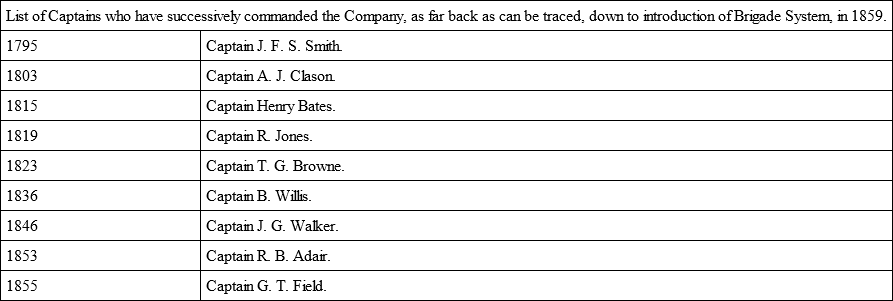
No. 1 °COMPANY, 5th BATTALION
(Became No. 8 Company in 1819),
Now "5" BATTERY, 5th BRIGADE.
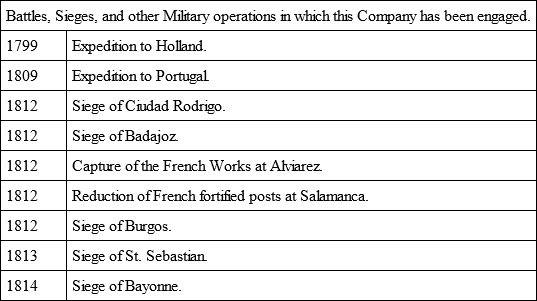

By a General Order, dated 22nd July, 1799, four companies of Artillery were raised, and added to two already existing, which were designated the East India Detachment, to form half a battalion; and on the 8th October in the same year a further augmentation was made, consisting of two companies, and a Colonel-Commandant. The addition of a Colonel en seconde and two Lieutenant-Colonels completed the organization of what was now known as the Sixth Battalion of the Royal Artillery. The Staff of the Battalion on its formation stood as follows: —
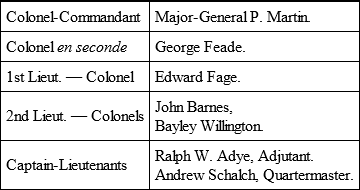
The companies, their stations, and commanding officers were as follows: —
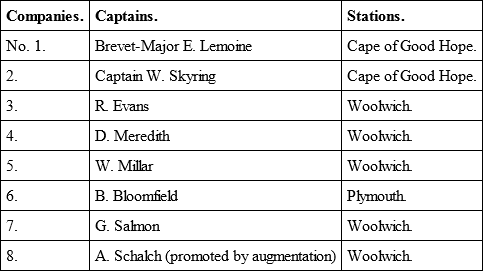
An augmentation of one Major and two companies to the battalion, – Nos. 9 and 10, – took place in December, 1800.
The companies called above "The East India Detachment," which formed the nucleus of the Sixth Battalion, embarked at Woolwich for India on the 19th April, 1791. They left that country for the Cape of Good Hope in 1798, arriving in October of that year, and remained until incorporated in the newly-formed battalion, in 1799. They are now C Battery 11th Brigade, and No. 6 Battery 5th Brigade. Prior to 1799, although part of the Royal Regiment of Artillery, they belonged to no battalion.
The following was the strength of the battalion in various years: —

From this date until 1847 the average strength of the battalion was 650.
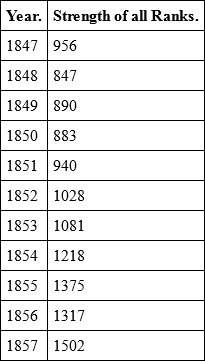
The following was the dress of the battalion at its formation, in 1799, as also of the whole Regiment, except the Horse Artillery: the officers wore blue cloth double-breasted coats, with scarlet lappels; the field officers had two epaulettes, the company officers only one, which they wore on the right shoulder; white kerseymere breeches; long black leather boots, fastened to the back part of the knee of the breeches by a black strap and buckle; and a cocked-hat, with gold-loop and button, and white feather. The non-commissioned officers and men wore blue cloth coats, single breasted, laced in front and on the cuffs and flaps; the staff-sergeants and sergeants with gold lace, and the rank and file with yellow worsted lace. The staff-sergeants wore two gold bullion epaulettes; the sergeants two gold-laced straps; the corporals two fringe epaulettes; the bombardiers one fringe epaulette on the right shoulder; the gunners two worsted straps.
The changes in dress during the succeeding years will be noted in the succeeding chapters of this work.
Annexed is the list, as in former cases, of the various companies, their successive Captains, and the military operations in which they were engaged. In the Sixth Battalion, as in the Horse Artillery, considerable confusion was created by the reduction, in 1819, of Nos. 5 and 8 companies, and the consequent altering of the numbers of Nos. 6, 7, 9, and 10 to Nos. 5, 6, 7, and 8 respectively. The reduction of the two junior companies, instead of Nos. 5 and 8, would have rendered the student's task a far easier one.
No. 1 COMPANY, 6th BATTALION
(One of the old East India Detachment Companies),
Now "C" BATTERY, 11th BRIGADE.

* N.B. – This was the only battery engaged at the Battle of the Tchernaya.
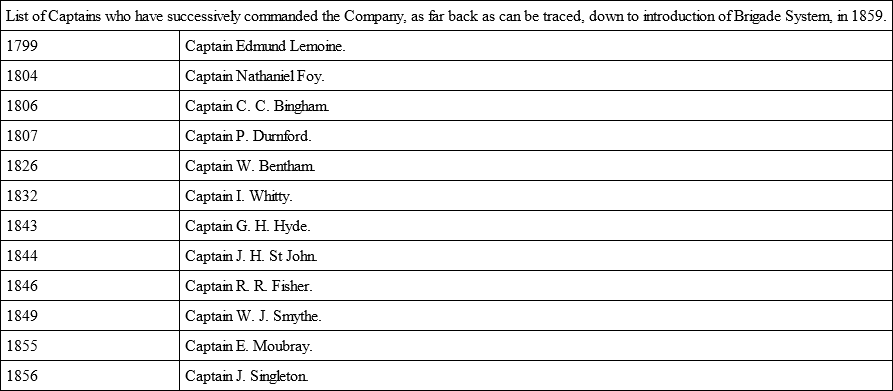
No. 2 COMPANY, 6th BATTALION
(One of the old East India Detachment Companies),
Now "6" BATTERY, 5th BRIGADE.

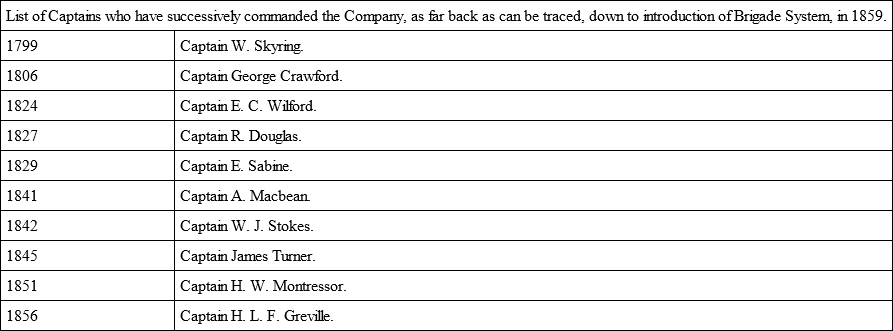
No. 3 COMPANY, 6th BATTALION,
Now "4" BATTERY, 2nd BRIGADE.

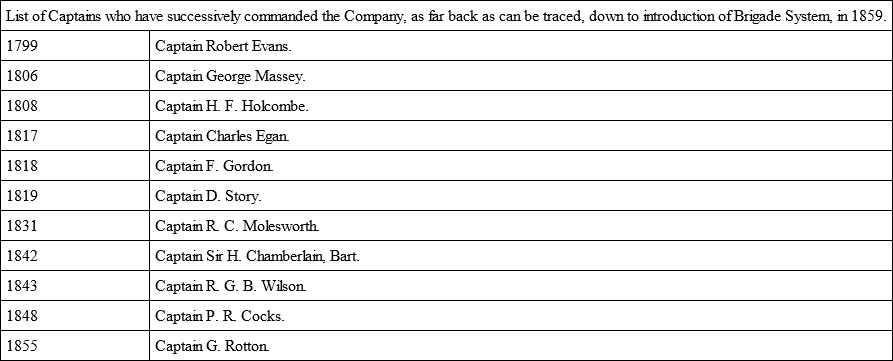
No. 4 COMPANY, 6th BATTALION,

